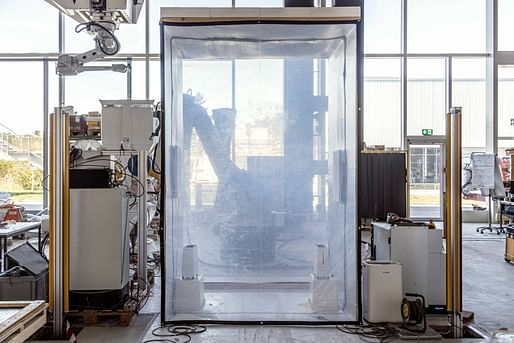
ETH Zurich has published details of new research into lightweight building components produced using 3D printing. Led by doctoral architecture researcher Patrick Bedarf, the Airlements project centers on cement-free mineral foams derived from recycled industrial waste.
Working within the institution’s Digital Building Technologies group led by Professor Benjamin Dillenburger, Bedarf’s project emerged from a doctoral thesis on lightweight insulating construction elements, and how complex shapes could be manufactured with fewer material inputs. Bedarf ultimately deployed a sustainable insulation material produced by the ETH spin-off FenX using recycled industrial waste.
FenX’s mineral foam material is mostly made from fly ash, a waste product from industrial blast furnaces. Bedarf’s process then deploys 3D printing to shape the material into bespoke building parts without the need for formwork, which is traditionally only partly reusable and more time-consuming.
“Without automation, traditional construction methods that save on materials are very time-consuming and expensive, especially due to labor costs,” Bedarf explained to ETH Zurich from his lab. “Take this piece, for example, which looks like a pizza,” Bedarf told ETH, pointing to a flat disc. “We printed several different types of these small 'pizzas' to begin with, and then moved on to bigger pieces to see whether foam produced by 3D printing is also suitable for large-scale applications.”
The prototype for the Airlement project comprises a monolithic six-foot-tall corner column made from four 3D printed foam segments. The four individual parts are stuck together with a mortar and sprayed with a white cement-free render. Each individual prototype is printed in less than an hour before being hardened for one week inside a controlled environment.

“The building parts can simply be printed in a factory, transported to the building site, and positioned where required,” Bedarf continued. “To make the component more robust, the hollow core can be cast with high-density mineral foam, eventually making it strong enough to act as a load-bearing structure.”
Having developed Airlement as an insulation material, Bedarf will now partner with FenX to expand the project’s use for wall elements in closed rooms.
News of the research comes one week after we reported on a 3D printed social housing apartment building aiming to become the first of its kind in Europe. Earlier in November, meanwhile, University of Buffalo students displayed their 3D printed ‘Archi-texture’ project in an exhibition at the Hong Kong Design Centre.
No Comments
Block this user
Are you sure you want to block this user and hide all related comments throughout the site?
Archinect
This is your first comment on Archinect. Your comment will be visible once approved.